Showing 13–24 of 30 results
-
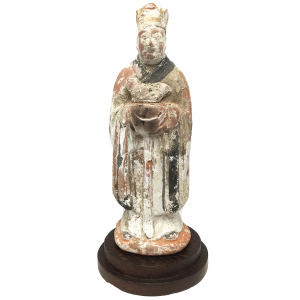
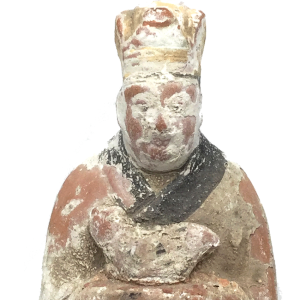
$395.00
H: 7.375” W: 2.75” D: 2.5” | FREE SHIPPING!
A group of 12 zodiac figures as mingqi sometimes accompanied the wealthy deceased in their tomb. This Ming dynasty earthenware figurine stands on a low circular base and wears an official’s hat and long flowing robes. It is difficult to identify the specific animal held here but it may be a rabbit, small dog or baby pig. The detailed figure is hollow and partially mould-made and unlike glazed mingqi, was covered with a white slip and painted using black and white pigments which are mostly extant.
-
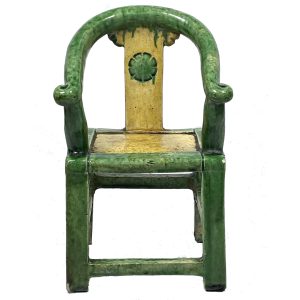
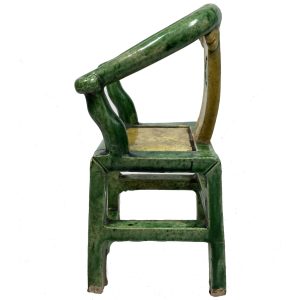
$685.00
H: 7.375″ W: 4.375″ D: 3.75″ | FREE SHIPPING!
Often ancestral figures were portrayed sitting in horseshoe chairs to reflect the high status of the figure they were portraying. As many earthenware mingqi, this well-modeled chair has a liberally applied thick green glaze resulting in expected drips around the stretchers. The seat is decorated with a yellow glaze imitating caning and the decorative carved design on the splat also has a yellow glaze and a carved decorative “clocklike” circular design. The bottom of the seat and legs are not glazed, as is usual. It is in very good condition with expected minor chips and minor glaze pitting and deterioration consistent with its age and long burial. It pairs perfectly with item 3330 and together would add to a fine collection of Chinese ceramics.
-
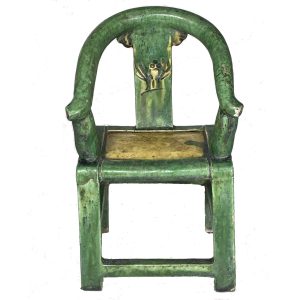
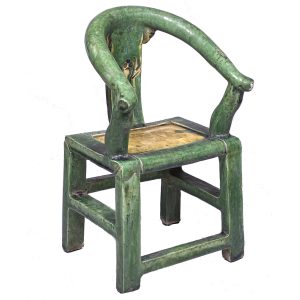
$685.00
H: 7.375″ W: 4.375″ D: 3.75″ | FREE SHIPPING
This charming miniature Ming dynasty ceramic horseshoe pottery chair is an accurate model of an impressive Ming chair that would have been made of a beautifully grained hardwood and constructed with a continuous horseshoe shaped top rail and a caned seat. The curved splat of a wood chair might have either carved or pierced motifs or medallions and straight or curved stretchers joining the legs in pairs at the same height on each side. Often ancestral carved figures were portrayed sitting in horseshoe chairs to reflect the high status of the figure they were portraying. This ceramic mingqi has a thick green glaze throughout which was liberally applied normal usual drips around the stretchers. The seat is decorated with a yellow glaze in imitation of caning as is the decorative carved design on the splat, but the bottoms of both the seat and legs are unglazed. The rail ends splay to the right and left for hand comfort and decorative effect are traditionally found in Ming Dynasty hardwood horseshoe-shaped chairs. It is in very good condition with minor chips and paint losses and fading due to its being buried underground in a tomb for centuries. It would be a fine addition to a collection of antique ceramics.
-
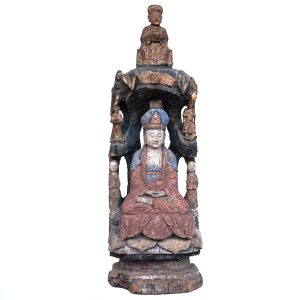
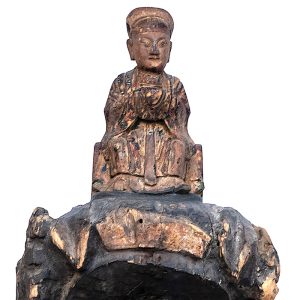
$5,900.00
H: 34″ W: 12 ” D: 15 ” SHIPPING INFORMATION REQUIRED. CONTACT US AT 213-568-3030
Guanyin clearly dominates this majestic carving, in meditation and wearing an ornate high blue crown centered with an Amitabha Buddha in a deep arched border and her traditional three-part robe extending to her pedestal throne topped by flat lotus leaves.This remarkable carving Nanhai-Guanyin is extremely rare, unique and difficult to interpret. We have never seen a Guanyin in her cave at Putuo surrounded by with two sets of attendants, her acolytes Shan Tsai and the Dragon Princess Longnu and a seated Taoist official/ priest or possible the donor at the apex. This was clearly commissioned by a very wealthy donor who wished to make a spiritual statement while emphasizing his reverence and status.
-
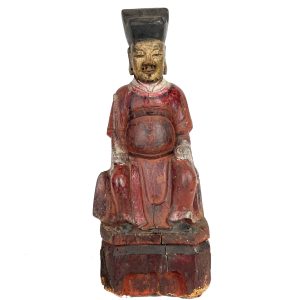
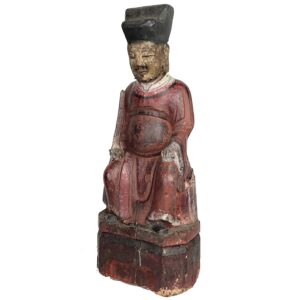
$875.00
H: 15.5: W: 6.125″ D: 4.125″ | free shipping!
This fine ancestor figure portrayed as a Chinese official with many indications of his high status. He sits on a backless chair upon a high decorative pedestal upon which his feet rest and . He wears officials attire: a futou cap and high collared red robe with double belt extending to his shoes. He sits in a formal pose with hands on his thighs holding a long slender hu tablet. His facial hairs indicate a mustache and beard, now partially lost, on his gilt colored face.
-
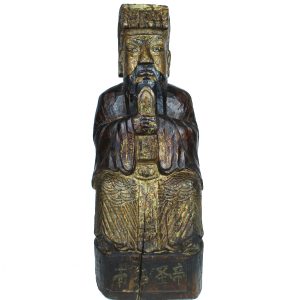
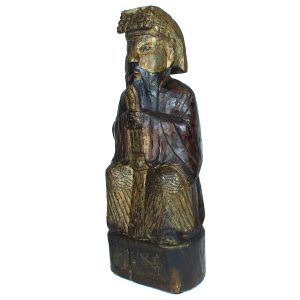
$395.00
H: 14.25” W: 5.5” D: 4” | FREE SHIPPING!
This unique and dense antique/vintage carving may represent the noted historical figure: the principal regent Dorgon of the first Qing Emperor Shunzhi who ruled from 1643-1650 as a”quasi” emperor based on the four-character inscription that reads “Southern Holy Emperor.” He is presented wearing an impressive and detailed hat and coat holding a hu tablet characteristic of one standing before an emperor.
-
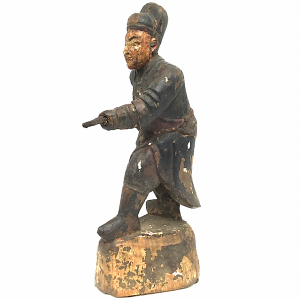
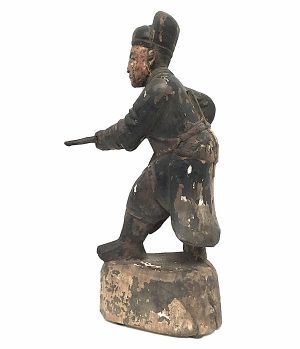
$315.00
H: 9″ W: 3.625″ D: 3.5″ | FREE SHIPPING!
This unusual ancestor-huntsman figure is like a similar example in the collection of described by the notable scholar Keith Stephens as “An Unusual and Extraordinary Ancestral Image” standing with legs spread firmly on a plain rounded triangular base holding an 19th century flint lock rifle while scouting for prey. Much of original paint has been lost or covered by darkened lacquer, but the flesh tone on the face and remnants of red and white paint remain.
-
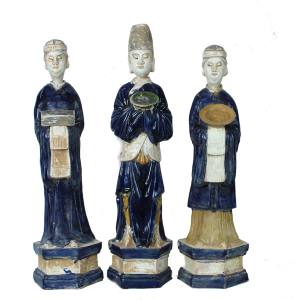
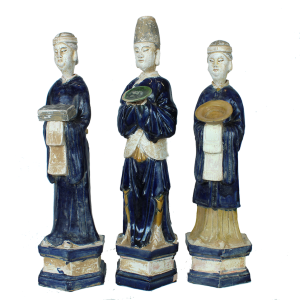
$4,985.00
H: 17.875″ W: 4.875″ D: 4.75″ | FOR SHIPPING INFORMATION CONTACT US AT 213-568-3030
This brilliant set of three Ming dynasty attendants – one male and two female – are in a unique category of refinement and elegance that reflects the importance and high status of the tomb, the deceased and the family that commissioned them. Standing on hexagonal bases with arms folded below their chests and presenting offerings to the deceased, their clothing and parts of the bases have a rare cobalt blue glaze for burial objcts, two have yellow glazed areas and all have painted unglazed areas. Their removable heads are highly detailed and beautifully modeled fitting inside high collars. These figures are presented and sold as a remarkable set reflecting their original presentation and condition.
-
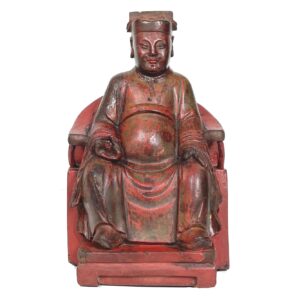
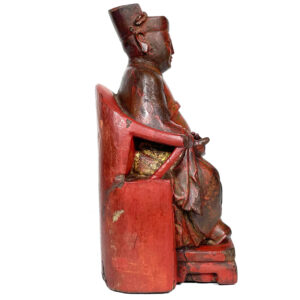
$650.00
H: 7.25” W: 4.625” D: 3.5” | FREE SHIPPING
This finely carved ancestor wears official’s attire and hat and sits in a horseshoe chair with his feet on a pedestal to emphasize his power and status, although he appears to be a lovwer level civilian official. It is masterfully carved and lacquered and is painted on front and back in red with traces of gilt – all propitious colors of “fu” as a wish for wealth, health, good fortune, long life and long life – that has faded over it years of use into a great patina.
-
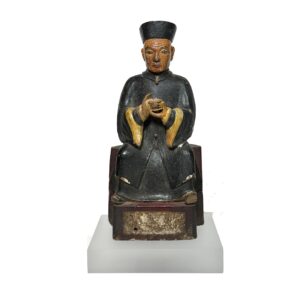
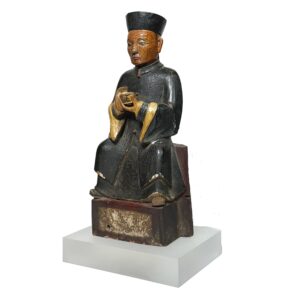
$675.00
H: 9 ” W: 5 ” D:3.5 ” | FREE SHIPPING in continental u.s.!
This finely carved, beautifully detailed statue of a Taoist Official was created using a combination of simplified geometric forms and colors to create a small but striking and significant piece. Holding the Elixir of Immortality, the statue symbolizes a wish for a long and happy afterlife. Mounted on a uniquely crafted frosted acrylic base, it complements any décor.
-
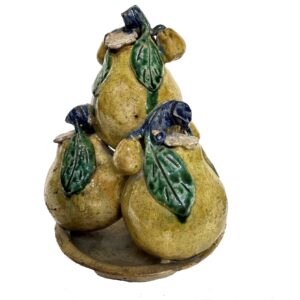
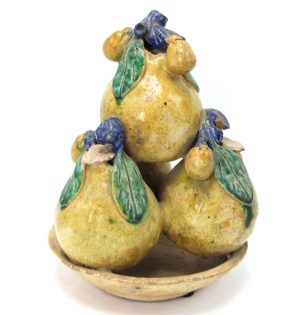
$375.00
H: 8.75″ DIA: 6.75 ” | FREE SHIPPING!
This colorful antique Shiwan stoneware food offering would have been placed on a Chinese home or temple altar to augment or in place of a plate of stacked fresh fruit. These offerings are still made honor the family’s ancestors, communicate with deities and bring prosperity, good luck and health to the home.
-
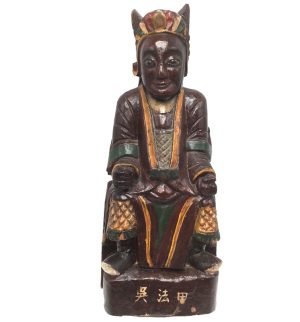
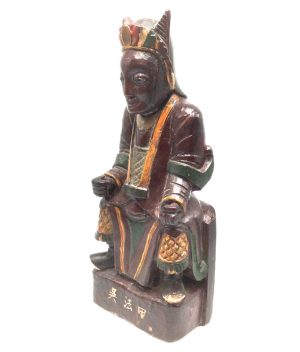
$295.00
H: 12.7” W: 3.375” D: 3”| FREE SHIPPING!
Images like this were commissioned by families to honor departed ancestors, and this family seems to have requested an amplified tribute by posing him with characteristics of Guandi, the god of war, or maybe it is Guandi very liberally depicted by a provincial artist. He sits on a high backless chair, hands on knees, one holding a small tael and the other poised to hold a sword, wearing military maille at the chest and knees, also used in depictions of Guandi. The calligraphy on the base is the name Wu (last) Fa Tian (first), the ancestor to whom the statue was dedicated.
End of content
End of content























